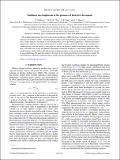| dc.contributor.author | Figliuzzi, B. | |
| dc.contributor.author | Chan, W. H. R. | |
| dc.contributor.author | Buie, Cullen | |
| dc.contributor.author | Moran, Jeffrey L | |
| dc.date.accessioned | 2017-06-30T14:29:55Z | |
| dc.date.available | 2017-06-30T14:29:55Z | |
| dc.date.issued | 2016-08 | |
| dc.date.submitted | 2016-06 | |
| dc.identifier.issn | 2470-0045 | |
| dc.identifier.issn | 2470-0053 | |
| dc.identifier.uri | http://hdl.handle.net/1721.1/110384 | |
| dc.description.abstract | The nonlinear phenomena that occur in the electric double layer (EDL) that forms at charged surfaces strongly influence electrokinetic effects, including electro-osmosis and electrophoresis. In particular, saturation effects due to either dielectric decrement or ion crowding effects are of paramount importance. Dielectric decrement significantly influences the ionic concentration in the EDL at high ζ potential, leading to the formation of a condensed layer near the particle's surface. In this article, we present a model incorporating both steric effects due to the finite size of ions and dielectric decrement to describe the physics in the electric double layer. The model remains valid in both weakly and strongly nonlinear regimes, as long as the electric double layer remains in quasiequilibrium. We apply this model to the study of two archetypal problems in electrokinetics, namely the electrophoresis of particles with fixed surface charges and the electrophoresis of ideally polarizable particles. | en_US |
| dc.publisher | American Physical Society | en_US |
| dc.relation.isversionof | http://dx.doi.org/10.1103/PhysRevE.94.023115 | en_US |
| dc.rights | Article is made available in accordance with the publisher's policy and may be subject to US copyright law. Please refer to the publisher's site for terms of use. | en_US |
| dc.source | American Physical Society | en_US |
| dc.title | Nonlinear electrophoresis in the presence of dielectric decrement | en_US |
| dc.type | Article | en_US |
| dc.identifier.citation | Figliuzzi, B.; Chan, W. H. R.; Buie, C. R. and Moran, J. L. "Nonlinear electrophoresis in the presence of dielectric decrement." Physical Review E 94, 023115: 1-14 © 2016 American Physical Society | en_US |
| dc.contributor.department | Massachusetts Institute of Technology. Department of Mechanical Engineering | en_US |
| dc.contributor.department | Massachusetts Institute of Technology. Department of Nuclear Science and Engineering | en_US |
| dc.contributor.mitauthor | Buie, Cullen | |
| dc.contributor.mitauthor | Moran, Jeffrey L | |
| dc.relation.journal | Physical Review E | en_US |
| dc.eprint.version | Final published version | en_US |
| dc.type.uri | http://purl.org/eprint/type/JournalArticle | en_US |
| eprint.status | http://purl.org/eprint/status/PeerReviewed | en_US |
| dc.date.updated | 2016-08-30T22:00:07Z | |
| dc.language.rfc3066 | en | |
| dc.rights.holder | American Physical Society | |
| dspace.orderedauthors | Figliuzzi, B.; Chan, W. H. R.; Buie, C. R.; Moran, J. L. | en_US |
| dspace.embargo.terms | N | en_US |
| dc.identifier.orcid | https://orcid.org/0000-0002-2275-4570 | |
| dc.identifier.orcid | https://orcid.org/0000-0002-0464-0385 | |
| mit.license | PUBLISHER_POLICY | en_US |
| mit.metadata.status | Complete | |
